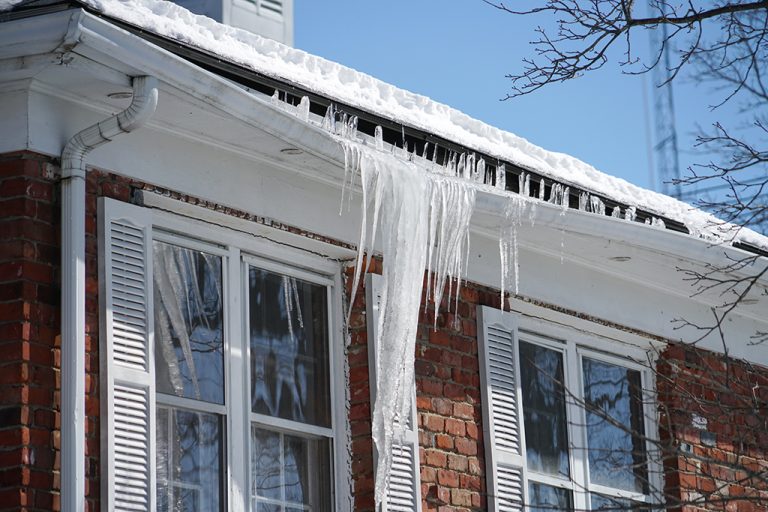
Is Your Gutter Ready for Winter? The Ice Dam Quiz to Test Your Gutter Knowledge
Winter is just around the corner, and while you may be ready to bundle up and embrace the chill, is your home prepared for the season’s harsh conditions? One of the most overlooked but critical areas to winterize is your gutter system. As temperatures drop, improperly maintained gutters can lead to ice dams—those stubborn blocks of ice that build up along your roof’s edge and can cause extensive damage if left unchecked.
Most homeowners don’t realize that simple maintenance steps can prevent these costly winter issues. So, how well do you know your gutters’ winter needs? Are they truly ready to handle the freeze-thaw cycles ahead? Take our Ice Dam Quiz to find out! In just a few minutes, you’ll discover essential tips for winter gutter maintenance and get insights into the health of your gutter system. Don’t let your gutters become a weak link this winter—let’s see if your knowledge measures up!

The Ice Dam Quiz
Ready to test your gutter knowledge? This quick quiz will help you find out if your gutters are truly ready for winter. Each question sheds light on common misconceptions and important tips that every homeowner should know to prevent ice dams. Let’s dive in!
Question 1: How often should you clean your gutters to prevent ice dams?
- A) Once a year
- B) Twice a year
- C) Only after a storm
- D) Never, if I have gutter guards
Answer: B) Twice a year
Explanation: Ideally, gutters should be cleaned once in the spring and once in the fall. Why? Leaves, twigs, and other debris can easily clog gutters, preventing water from draining properly. When winter hits, these blockages can freeze, creating ice dams that stop water flow and cause it to back up under your roof. Even if you have gutter guards, they still need occasional cleaning to ensure everything flows smoothly!
Question 2: True or False: Gutter guards make your gutters fully winter-proof.
Answer: False
Explanation: Gutter guards are a great help, but they don’t make your gutters completely immune to winter problems. Snow and ice can still pile up on top of gutter guards, and smaller debris can sneak through. Regular maintenance is still needed to keep gutters free of blockages and prevent ice dam formation.
Question 3: What temperature change is most likely to lead to ice dams?
- A) Constant freezing temperatures
- B) Warm days and freezing nights
- C) Below-zero temperatures throughout winter
Answer: B) Warm days and freezing nights
Explanation: When daytime temperatures rise and snow starts to melt, that water trickles down to the colder edge of the roof and refreezes at night. Over time, this creates a thick layer of ice—a dreaded ice dam. Consistent freezing temperatures are less likely to form dams because no melting occurs to start the process.
Question 4: Where should downspouts ideally direct water in winter?
- A) Directly onto the driveway
- B) Away from the foundation
- C) Toward a storm drain
Answer: B) Away from the foundation
Explanation: Downspouts should always direct water away from your home’s foundation, ideally at least five feet away. This prevents water from pooling around your home, where it could freeze and form dangerous ice patches or leak into your basement.
Question 5: What’s a common sign that ice dams might be forming?
- A) Icicles hanging from gutters
- B) Snow accumulating on the roof
- C) Condensation inside the attic
Answer: A) Icicles hanging from gutters
Explanation: Icicles may look pretty, but they’re a major red flag. They form when melting snow runs down to the gutter edge and refreezes. This buildup can lead to ice dams, causing water to pool and possibly leak into your roof or walls.
Question 6: Which type of roofing material is most prone to ice dams?
- A) Metal roofing
- B) Asphalt shingles
- C) Clay tiles
Answer: B) Asphalt shingles
Explanation: While all roofs can develop ice dams, asphalt shingles are particularly susceptible to the freeze-thaw cycle that contributes to dam formation. Their design makes it easier for water to seep in and freeze, so keep an eye on your gutters and roof if you have this type of material.
Find roof and gutter cleaning tips here: Top Roof and Gutters Cleaning Tips
Question 7: Which of these measures is most effective for preventing ice dams?
- A) Installing heat cables
- B) Attic insulation and ventilation
- C) Shoveling snow off the roof
Answer: B) Attic insulation and ventilation
Explanation: While all these measures can help, the most effective way to prevent ice dams is to maintain consistent attic temperatures through proper insulation and ventilation. This stops warm air from escaping to your roof, which would otherwise cause snow to melt unevenly and lead to ice dams. Heat cables and roof shoveling can help in emergencies, but a properly insulated attic is your best defense.

Ready for Winter?
How did you do? Each question reveals key insights into keeping your gutters—and your home—safe from winter’s worst effects. If you missed a few, don’t worry! Knowing what to look out for is half the battle, and you’re already one step closer to protecting your home from ice dams this winter.
Up next, check out our results section to find out how winter-ready your gutters are and learn a few extra tips to keep them in top shape all season long!
Results & Explanation
Congratulations on finishing the Ice Dam Quiz! Now, let’s see how winter-ready your gutters really are. Based on your score, you’ll get insights on what steps you might still need to take to keep your gutters—and your home—safe from winter damage. Remember, even small improvements can make a big difference when winter’s chill sets in!
Score Breakdown
0-3 Correct: “Uh-oh, Your Gutters Might Not Be Winter-Ready Yet”
- Explanation: Don’t worry, winter prep doesn’t have to be complicated! Start by scheduling a thorough gutter cleaning to remove any debris that could lead to clogs and ice dams. Consider professional help to inspect and improve your attic’s insulation and ventilation to keep temperatures even. With a few small changes, you’ll be well on your way to preventing ice dams and avoiding costly repairs.
4-6 Correct: “Almost There! A Few Tweaks Can Make All the Difference”
- Explanation: You’ve got a solid understanding of winter gutter care, but a little extra prep will ensure your home is safe all season. Make sure to check that downspouts direct water away from your foundation, and consider adding a gutter guard if you don’t have one. With these extra steps, your gutters will be better prepared to handle winter’s freeze-thaw cycles.
7-10 Correct: “Great Job! Your Gutters Are Winter-Ready”
- Explanation: Excellent work! You’ve clearly got a handle on how to protect your home from winter’s unique challenges. Keep up the good work with regular gutter maintenance, and maybe even help a neighbor or friend by sharing your knowledge. Winter-proofing is about being proactive, and you’re set for a season of peace of mind.
Extra Tips for Winter Gutter Care
Regardless of your score, here are a few final tips to make sure your gutters stay in top shape:
- Install Gutter Extensions: Make sure downspouts direct water at least five feet away from your home to prevent foundation and basement issues.
- Trim Overhanging Branches: Trees can drop debris into your gutters, leading to clogs. Trim any branches hanging over your roof to reduce the buildup of leaves and twigs.
- Consider Heat Cables for High-Risk Areas: If your home is prone to ice dams, heat cables installed along the roof edge can help melt snow and ice before they form dangerous ice dams.
- Check Insulation & Ventilation Annually: This keeps attic temperatures consistent, which is key to preventing ice dams. Insufficient insulation lets warm air escape, leading to those damaging freeze-thaw cycles.
- Clear Snow from Your Roof After Heavy Snowfall: Using a roof rake after major storms helps reduce the load on your roof and minimizes the chances of ice dams forming.

Conclusion: Get Ready for Winter with Confidence
Winter can be a tough season for homes, but with the right preparation, you can keep your gutter system—and your entire house—safe from ice dams and the damage they bring. Whether you’re already a gutter guru or just getting started with winter prep, a little extra attention now can prevent major headaches (and expenses!) down the road.
If you’re ready for a professional inspection or need help getting your gutters winter-ready, reach out to a local gutter expert. And don’t forget to share this quiz with friends and family—they might discover something new about their own winter home prep!

